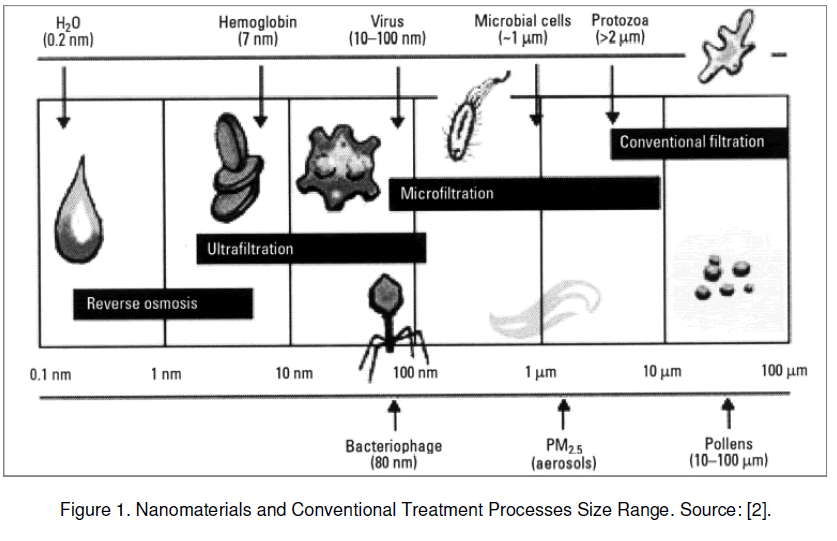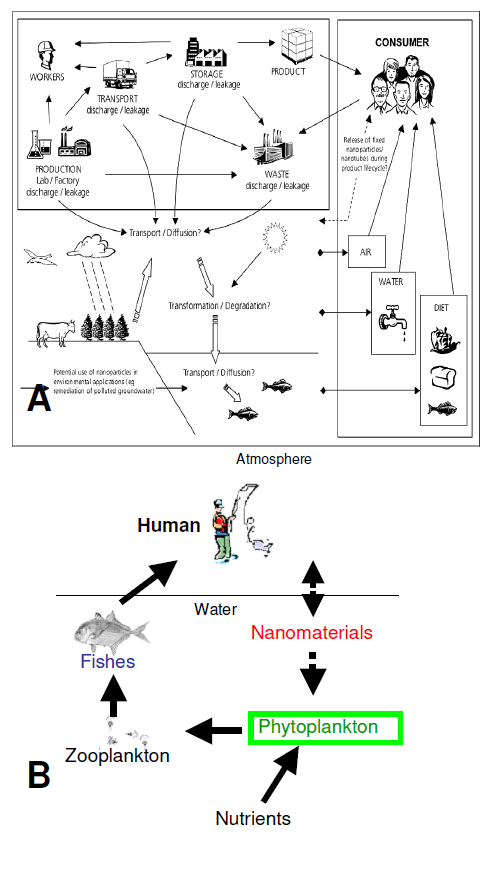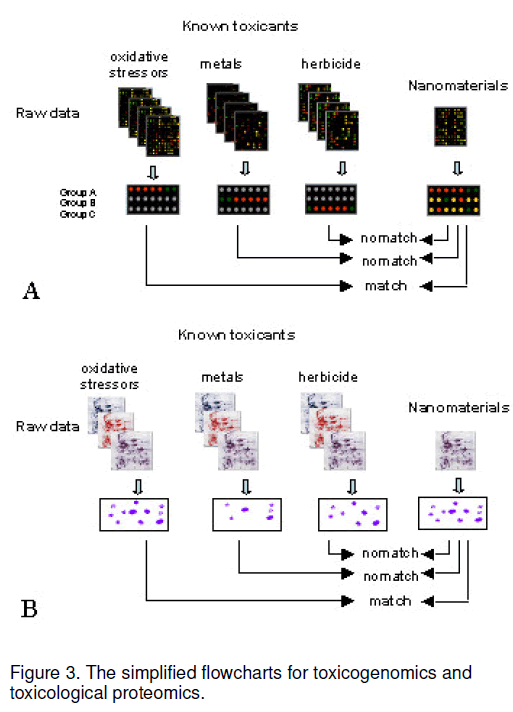Old bottle with new wine: algal indicators for nanotechnology-based toxicology
Jiangxin Wang and Qiang Hu
School of Life Sciences,Arizona State University,Tempe,85281 USA
Abstract
This review is to talk about an advanced method applied in a totally new field. Since 1960s, algae have been applied as sensitive potential indicators of environment. On the other hand, nanotechnology is a relatively new term to us, and what’s more, its toxicological research is a newborn topic today. Though handful of papers focused on nanomaterial toxicity to human cells and fish were reported, there is no reference on nanotechnology-based toxicological environmental assessments. In this study, the advantages of using algae as indicators for nanotechnology-based toxicity and some molecular biomarkers and methods were discussed and evaluated.
Keywords
algae,bio-indicators,biomarkers,environment,nanotechnology,toxicology
1. Nanomaterils & its benefits
Manufactured nanomaterials,which are 100 nanometers (0.1 micrometers) or less in diameter,are already used in commercial products in powders,sprays,and coatings that are being used in a variety of products,including sunscreens,automobile parts,tennis rackets,scratch-proof eye glasses,stain-repellent fabrics,self-cleaning windows,and more (Figure 1) [URL1]. The intentional manufacture of nanomaterials is already under way,and this new industry is gearing up worldwide. By 2005,the global market for nanoparticles will be close to $1 billion [URL2]. According to the ETC Group [URL3],which follows nanotech developments carefully,an estimated 140 companies are now producing nanomaterials. Mitsubishi Chemical in Japan has reportedly begun construction of a plant to manufacture nanotubes at the rate of 120 tons per year,with plans to increase output to 1500 tons per year by 2007 [1]. The U.S. government's space agency,NASA,plans to spend the next five years scaling up the production of nanotubes. At this time,there are at least 44 elements in the Periodic Table commercially available in nanoscale form,and more elements are being added to this list yearly. The potential impact of nanoparticles on human health and the environment could be enormous following such a rapid market increase.
Nanomaterials are tiny versions of the conventional materials. These include the diverse atomic elements of periodic table,both benign and toxic. Taking advantage of these properties existing at nano-scale novel materials can be structured that may have entirely new properties never before identified in nature. Nanomaterials due to their novel properties like increased surface area,provides material efficiency i.e.,less materials more advantages,Nanomaterials use in traditional process and products can provide resource efficiency (material + energy) and other ecological benefits like source reduction,pollution abatement,eco-friendly coatings like self-cleaning,resistance to heat UV etc.
2. Novel properties of nanomaterials
In terms of their impacts on the environment and the specific properties that can lead to such impacts,the nanomaterials novel properties can be categorised into two forms they are: Intrinsic properties and Nano-scale structuring properties.
The first is the intrinsic properties of the materials due to their chemical composition. For example,cadmium selenide (CdSe) nanocrystals are made of cadmium and selenium,so it is natural to expect that the impacts of the CdSe nanocrystals will bear some striking resemblance to that we would find from the component materials (e.g.,cadmium is toxic). Another example is that,toxic gallium arsenide (GaAs) a precursor used in the microchips for computers and cellular phones [2].
The second class of criteria consists of those properties that are present precisely because of the nano-scale structuring [3]. These include:
Increased surface area: This means that a reactive material will likely be even more reactive in a nanostructured form because its surface exposure to the environment is so much greater to pick another. For example,if a material is not itself intrinsically toxic but adsorbs on its surface a toxic material,then a higher surface area increases the nanomaterial’s capacity to transport a toxin.
Heightened reactivity: Complementing the above first characteristic,just due to their small size and higher surface curvature (large number of atoms on surface),the intrinsic reactivity of nanomaterials tends to be higher than that of bulk materials,thus providing active sites for reactions.
Modified properties: A key criterion for something to be considered a nanomaterial is whether some property of the material is size-dependent,e.g.,the tenability of optical absorption of metals by varying its thickness. Making a material nanoscopic might make it more absorptive under some relevant conditions (e.g.,absorbing light),which in turn could have some unusual effects. For example,cadmium selenide crystals at 1.5 nm will appear yellow,4 nm will appear red and larger particles will appear black. This discovery is now being applied for coatings (using ZnO2 and TiO2) to filter UV radiation. But these coated materials biological behaviour in the environment is still a research question.
Modified exposure,transport,or accumulation mechanisms: This property of nanomaterial is due to the above-mentioned novel properties in a material. For example,a nano-scale particle may (and likely will) have an increased likelihood of bio-uptake,perhaps exposing biological systems to materials in parts of their bodies that have never been exposed to them before. And a nanomaterial self-assembled in a laboratory can replicate in the environment due to exposure with related materials [2]. Nanomaterials will have enhanced or entirely different properties compared to their parent materials. Because difference in materials is not how the materials are made,but how best the atoms are arranged in them.
3. Nanomaterials toxicity
The toxicity and exposure risk of nanomaterials is an active current research area. Research in federal laboratories,private industry,and academia is now in progress to determine how the nanotechnologybased materials may differ from conventional ones in their implications for public health and the environment. For example,single walled carbon nanotubes engendered different tissue response than ultra-fine carbon [4,5],cadmium selenide dots and fullerenes were phototoxic to cells [6]. Researchers at the Southern Methodist University in Dallas have found that buckyball can cause significant brain damage in fish. The preliminary study is only small but has demonstrated that nanoparticles can cause toxic effects in an aquatic species [7].
4. Nanomaterials & Environment
However,up to date little is known about the behaviour,exposure routes,and fate of nanomaterials after their release into the environment,especially the water environmental ecosystem.
It is in the water that many substances have their most significant environmental effects; even if only sparingly soluble,materials present in water can become degraded,transformed and accumulated in a variety of ways.For nanotechnology applications,the overall concentration of buckyballs in this colloidal form is too low (~10ppm) to be relevant for applications; for environmental scientists,this concentration is over 100-fold the aqueous solubility limit of polyaromatic hydrocarbons (PAHs). As nanoscale materials are in the same range as viruses and even smaller than naturally occurring colloids,these can easily escape during the current conventional treatment processes,and enter the food chain.
According to researcher (CBEN,Rice University,USA) Mark Wiesner,tests that measure the accumulations of materials in the livers of laboratory animals have demonstrated that nanomaterials accumulate within organisms and that,nanomaterials,even inorganic ones,have been absorbed by living cells. If bacteria can take them up,then there is an entry point for nanomaterials into the food chain.
With the increasing use and disposal of manufactured nanomaterials,it seems inevitable that they will enter the environment. Because of their very small particle size these materials may be able to move and translocate quickly in soil and sediment. Consequently,it is vital to establish methodologies and protocols to ascertain the impact of nanomaterials on human health as many manufactured nanomaterials are prepared and processed in liquids [8]. In water ecosystem,phytoplankton (microscopic algae) plays a center role as the primary producer (Figure 2 ).
Figure 2. A: Some possible exposure routes for nanoparticles and nanotubes based on current and potential future applications. Very little is known about exposure routes for nanoparticles and nanotubes and this figure should be considered with this in mind (Adapted from master thesis of Mohammad Abdul Hameed Hyder, 2003); B: Nanomateials in food chains in aquatic ecosystem.
Figure 2 . A: Some possible exposure routes for nanoparticles and nanotubes based on current and potential future applications. Very little is known about exposure routes for nanoparticles and nanotubes and this figure should be considered with this in mind (Adapted from master thesis of Mohammad Abdul Hameed Hyder,2003); B: Nanomateials in food chains in aquatic ecosystem.
5. Algae & environment
A food chain is the path of food from a given final consumer back to a producer (Figure 2B). For instance,a typical food chain in a water environmental ecosystem might be:
phytoplankton→zooplankton→fishes→human
Biological magnification is the tendency of pollutants to become concentrated in successive trophic levels. Often,this is to the detriment of the organisms in which these materials concentrate,since the pollutants are often toxic.
Bio-magnification occurs when organisms at the bottom of the food chain,phytoplankton,concentrate the material above its concentration in the surrounding soil or water. This is the first step in bio-magnification; the pollutant,e.g. nanomaterial,is at a higher concentration inside phytoplankton than it is in the environment. The second stage of biomagnification occurs when the producer is eaten. Remember a pyramid of biomass that relatively little energy (only ~10%) is available from one trophic level to the next,from phytoplankton to zooplankton here. This means that a consumer (of any level,zooplankton,fishes and human) has to consume a lot of biomass from the lower trophic level. If that biomass contains the pollutant,the pollutant will be taken up in large quantities by the consumer. The "best" example of biomagnification comes from DDT. As the bio-magnification result,the last consumer,human,will concentrate the highest concentration of nanomaterial.
This aspect has also attracted the attention of legislative bodies,prompting the US EPA and other agencies to fund research on the potential health effects and environmental impact of manufactured nanomaterials.
Phytoplankton harness new energy from sunlight and provide many other organisms as a means of food due to this while zooplankton are also an important source of food for many species,e.g. fishes. Thus,phytoplankton will be the first step/ barrier for nanomaterial accumulation by the food chain in water ecosystem. As primary producers,algae are most directly affected by physical and chemical factors,of course including nanomaterials.
6. Algae as environmental indicators
Actually,there are lots of advantages of using algae as environmental indicators. Algae generally have rapid reproduction rates and very short life cycles,making them valuable indicators of shortterm impacts. Sampling is easy,inexpensive,requires few people,and creates minimal impact to resident biota. Relatively standard methods exist for evaluation of functional and non-taxonomic structural (biomass,chlorophyll measurements) characteristics of algal communities. Algal assemblages are sensitive to some pollutants which may not visibly affect other aquatic assemblages,or may only affect other organisms at higher concentrations (i.e.,herbicides) [9].
7. Biomarkers for nanotechnology-based toxicology
A number of molecular parameters can be measured in order to address the cellular stress reaction. These parameters serve as biomarkers in allowing us to estimate the toxicity of individual chemicals,mixtures of chemicals,or complex environmental samples. One possibility is to measure the concentration or enzymatic activity of stress proteins after exposure to a toxin. There are a large body of research reported the use of algae as environmental indicators. Besides the standardized assessment,algal growth inhibition test (ISO 8692,OECD 201 and DIN 38412 L33),there are some other powerful parameters for toxin exposure.
The stress protein cytochrome P450 monooxygenase is a frequently used biomarker of a range of organic contaminatants,such as PCBs,dioxin and dibenzofuranes. It presents in vertebrates as well as invertebrates and can be measured in cells or cell lines of both wild and laboratory animals. Cytochrome P450 monooxygenase plays a central role in metabolic detoxification reactions. This is why the concentration and activity of this stress protein markedly increases after exposure to contaminants. Mitochondrial membrane potential: it is generated by mitochondrial electron transport chain,which drives a proton flow from matrix through inner mitochondrial membrane to cytoplasm,thus creating an electrochemical gradient. This gradient is in turn responsible for the formation of ATP molecules by F0-F1 ATP synthase. For this reason it is an important parameter for mitochondrial functionality and an indirect evidence of energy status of the cell.
Metallothionein induction: Metallothioneins(MTs) are low molecular weight,cysteine-rich metalbinding proteins found in a wide variety of organisms including bacteria,fungi and all eukaryotic plant and animal species.
Phytochelatins induction: Phytochelatins are metal-binding peptides produced by eukaryotic marine phytoplankton in response to metal exposure and may function as bioindicators of metal contamination in coastal seawater.
Another method is to determine the concentration of mRNA. Molecular methods for measuring changes in mRNA concentrations are highly specific,quantitative,sensitive and quick,e.g.,realtime RT-PCR application with some special stress genes,like uspA,hsp70 etc. [10].
The methods described above primarily target single stress genes or proteins. In the case of environmental samples,we often don’t know the exact composition of the contaminants and it would be advantageous to monitor a number of stress genes and proteins simultaneously. Ideally,it would then be possible to identify contaminants based on the reactions that are observed. Furthermore,there is often only one toxic effect described for most contaminants,although we can expect that most contaminants will exhibit a complex toxicity pattern and that there are cellular effects,which are yet unknown. New technologies,based on extensive gene and protein analyses,appear to be very promising. Large numbers of genes or partial genes are fixed on so-called DNA-chips and then subject to tests (Figure 3A). With the sequencing of entire genomes,techniques in genome analysis are taking on a central role in toxicity research. At the same time,methods known as “proteomics” have been developed,where the protein composition of a cell as a whole can be characterized (Figure 3B). Some of the more powerful methods can already separate more than 10000 different proteins.
These traditional and new methods will not only let us identify new stress genes and proteins to nanomaterial stress,but also will allow us to examine the stress reaction of a cell or an organism as a whole,which is typically characterized by a complex interaction of a number of factors including stress factors. By this way,we could unravel the nanomaterial toxic action and mechanism to algae,and finally understand the impacts of nanomaterials to our environment and health.
References
- Fried J. (2002) Japan Sees Nanotech as Key to Rebuilding its Economy. Small Times,January 07,2002.
- Masciangioli T.,Zhang WX. and Zhang W. (2003) Environmental Technologies at the Nanoscale. Enviro.n Sci. Technol.,37(5): 102A- 108A.
- Hyder M. (2003) Nanotechnology and environment: Potential Applications and Environmental Implications of Nanotechnology. Master’s thesis. Technical University of Hamburg-Harburg Germany. pp97-98.
- Lam C.,James J.,McCluskey R.,and Hunter R.L. (2004) Pulmonary Toxicity of Single-Wall Carbon Nanotubes in Mice 7 and 90 Days After Intratracheal Instillation. Toxicol. Sci.,77: 126- 134.
- Warheit D.B.,Laurence B.R.,Reed K.L.,et al. (2004) Comparative Pulmonary Toxicity Assessment of Single-wall Carbon Nanotubes in Rats. Toxicol. Sci.,77: 117-125.
- Colvin V. (2003) The potential environmental impacts of engineered nanomaterials. Nature Biotechnol.,21: 1166-1170.
- Oberdorster E. (2004) Manufactured nanomaterials (fullerenes,C60) induce oxidative stress in the brain of juvenile largemouth bass. Environ Health Perspect,112(10): 1058-62.
- Dreher K.L. (2004) Health and Environmental Impact of Nanotechnology: Toxicological Assessment of Manufactured Nanoparticles. Toxicol. Sci.,77: 3-5.
- Barbour M.T.,Gerritsen J.,Snyder B.D.,et al. (1999) Rapid Bioassessment Protocols For Use in Streams and Wadeable Rivers: Periphyton,Benthic Macro-invertebrates,and Fish (2nd Ed.),EPA 841-B-99-002,1999.
- Power M.,van der Meer J.,Tchelet R.,et al. (1998) Molecular-based methods can contribute to assessments of toxicological risks and bioremediation strategies. J. Microbiol. Methods,32: 107-119. URL1ETC Group,2003,https://www.etcgroup.org/documents/NRsizematter sfinal.pdf. URL2ETC Group,2003,https://www.etcgroup.org/documents/NRsizematter sfinal.pdf. URL3ETC Group,https://www.etcgroup.org/.

Open Access Journals
- Aquaculture & Veterinary Science
- Chemistry & Chemical Sciences
- Clinical Sciences
- Engineering
- General Science
- Genetics & Molecular Biology
- Health Care & Nursing
- Immunology & Microbiology
- Materials Science
- Mathematics & Physics
- Medical Sciences
- Neurology & Psychiatry
- Oncology & Cancer Science
- Pharmaceutical Sciences



